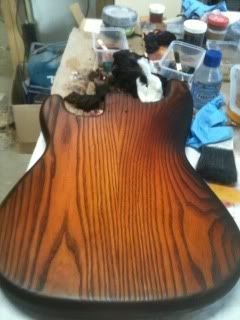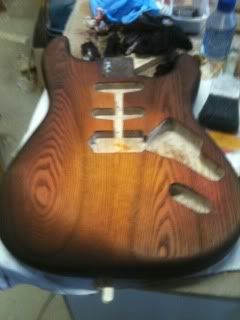 Thanks: 0
Thanks: 0
 Likes: 0
Likes: 0
 Needs Pictures: 0
Needs Pictures: 0
 Picture(s) thanks: 0
Picture(s) thanks: 0
Results 1 to 10 of 10
-
11th September 2011, 04:43 PM #1
 Hard Shelac prob or grain filler prob
Hard Shelac prob or grain filler prob
Hi,
I have been working on this Ash guitar body.My procedure was Sanding sealer,Grain filler,dye,hard shelac,
Before I started the shelac,the timber was very smooth .I noticed now is has some very rough spots on it which almost look like the grain is opened up.
I am not sure if its that or something is happening under the shelac....
The photos are a bit hard to tell,


-
12th September 2011, 06:53 AM #2

Ok,I sanded this back and found that it was in the shelac finish.
It looks like I will need to sand it right back to bare wood and start again..Not a very good job.
What would have caused the Hard Shelac to "Wrinkle" if thats the word ?
It is a water based dye I am using and I let it dry for about 10 days.
What is the best way to get all the shelac off.Should I wipe it over with metho or something then sand it ?
I still need to be avle to re dye it .
Thanks
Greg
-
13th September 2011, 11:14 AM #3

If the finish is wrinkled it is most likely too heavy a coat and a second and subsequent heavy coat(s) too early. Also possible that the shellac wasn't well mixed (shaken in bottle or well stirred if decanted) before either first or second application and subsequent.
Inexperience with shellac application, a not so good brush, or not so good brush application or spray application can also be part of the problem.
What sanding sealer did you use?
What grain filler (was it also water based)? What water dye (was it ours or an aniline dye)?
How many coats?
Was it brushed or sprayer?
If brushed what sort of brush (pic if possible)?
Always a good idea to do a sample board with exactly the same method before finishing unless you have a thorough knowledge of the products and their interaction with one-another.
Stripping may need to be done with paint stripper or one hell of a lot of abrasive.
What is the "Best by" date on the bottle of Hard Shellac?
I am not having a go at your finishing abilities here just trying to get to the bottom of your problem. So any answers and extra info you can give, no matter how small or seemingly insignificant could help.
Neil
PS Better photo's may help as well.
-
13th September 2011, 12:10 PM #4

Just had another look at the pics and I'm presuming this is Aussie Mountain Ash or KDH or similar. If so some of it can tend to go a bit explosive or pockmarked even if grain-filled although it's hard to tell from the pics if that's the problem.
-
13th September 2011, 07:29 PM #5
-
14th September 2011, 10:24 AM #6

How are you wiping it on and what are you wiping it on with?
Not really sure that just wiping it on is a really good idea as it would think it would be pretty hard to get a really good finish unless it was being wiped on as in french polished.
Shouldn't be a problem with the sealer or aniline dye (I haven't used aniline under it but that should be fine as it's waterbased). Timbermate can cause problems unless fully sanded back and well dusted off.
I'm still presuming this is Mountain Ash or one of the many other KDH timbers and if so it can be a problem because it is inclined to swell and go a bit rough so needs to be wet down first, allowed to dry well a couple of days then sanded to get rid of the swollen grain, wet again if needed and sanded again, then sanding sealer and light sand again if it raises even the most minute bit of grain.
You are adding water to the timber with the filler and also the dye. Both of these can make the grain of ash swell quite considerably. So it is pretty important to try and get all of the possibility of swelling out of the way with the pre wetting and sanding before applying them.
Ash wouldn't be my first choice of a timber to use water dye and shellac on, matter of fact it would be way down the list of timbers.
Definitely do a trial on a piece of ash with a similar grain (not on a bland grainless bit). and don't forget there will be shaped sections with end grain so make sure your practice/test piece has some shaped bits in it because these will react completely different to the dead flat sections.
Consider brushing or french polishing if brushing get yourself a good brush or two (look here) if french polishing and you don't have one get hold of "A Polishers Handbook"
Hope this is of some help.
Neil
-
14th September 2011, 11:04 AM #7
-
15th September 2011, 07:07 AM #8
 Start again
Start again


Ok,I took it right back to bare wood and have got to this point with the dye.
I am pretty happy with the colour .The photo doesnt really show the burst but it looks OK.
Should I now (After the water aniline dye dries in about a week) put a coat of Ubeut Sanding Sealer over the dye before I start French Polishing with the hard shelac or is that a waste.
I see what Neil is saying about the Grain in the Ash.I filled it with Timbermate and it was as smooth as a , and it has now opened up in a couple of small spots. Will the shelac fill these spots eventually .
Thanks
Greg
-
15th September 2011, 08:35 AM #9

Problem now is the sanding sealer or shellac could blow the grain out again as is the want with ash. What you really need to do is sanding sealer leave it overnight then sand off any nibs or exploded grain with something like 1200 grit if there is still open pores give it a bit of a refill and sand again.
Shellac will eventually fill pores but you'll need a lot of shellac and by the time the pores have filled you'll have a ton on the surface and problems, if you're not careful. So in this instance I would try and get all the grain filled especially if there is a problem spot because it will most likely turn into a bigger problem down the track.
One coat of sanding sealer should show up any flaws and make it easier to fix. You can fill and dye over the sealer after denibbing with 1200. It is possible that the extra filler could blow the grain out again but hopefully not. Clean it up again, give it another sanding sealer and wait to see what happens. All being equal it should be ok to proceed with the polishing. Use weak coats of shellac to start with (maybe 4parts meth) or even start off with a few rubbers of 6 to 1 just to see what the grain is going to do. I'm pretty sure the timber will have been your problem and not the shellac or your finishing method.
Pity you can't leave it as it is because the dying looks very nice in the pics.
Good luck with it.
Neil
-
15th September 2011, 01:25 PM #10

Thanks Neil,
I really appreciate your advice.
Regards
Greg
Similar Threads
-
Computer prob help!
By Harry72 in forum NOTHING AT ALL TO DO WITH RENOVATIONReplies: 15Last Post: 29th March 2007, 05:00 PM -
'Pute Prob.
By Peter R in forum NOTHING AT ALL TO DO WITH RENOVATIONReplies: 4Last Post: 16th January 2005, 01:21 PM -
Pergola prob;ems
By Iain in forum PERGOAS, GAZEBOS, STROMBELLAS & ROTUNDASReplies: 1Last Post: 9th May 2002, 01:01 AM








 Reply With Quote
Reply With Quote



Bookmarks